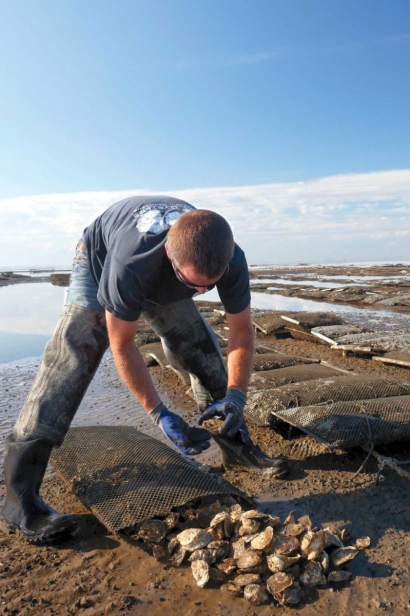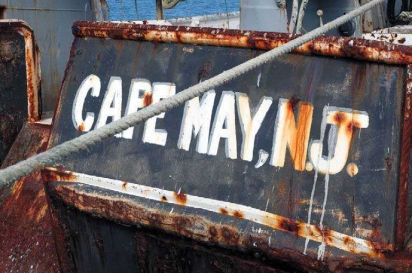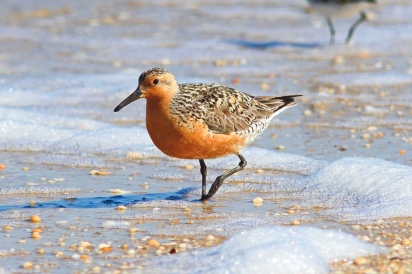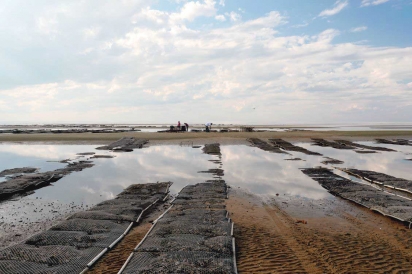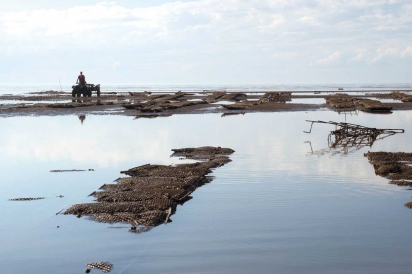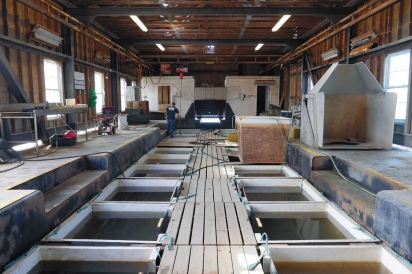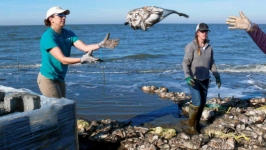New Jersey Oysters and Knots
“Here are some bags ready to be split,” says Brian Harman on a warm, sunny day last October before lifting a 40-pound bag and smiling at the tinkling sound made by the jostling of some 250 oysters. He wears black rubber boots that rise just a few inches short of the bottom of the back pockets on his blue jeans. He’s got on a T-shirt that says “Eat Oysters,” sunglasses to cut the glare, and blue work gloves.
Harman, 29, is the oyster farm manager for Atlantic Capes Fisheries, which operates the state’s largest oyster farm. We’re standing on the tidal mud flats of the Delaware Bay, near the town of Green Creek, on the Cape May peninsula—nearly as far south in Jersey as you can get. The oysters grow inside mesh bags fastened to row after row of shin-high metal racks, all located within an Aquaculture Development Zone (ADZ) leased from the state’s Bureau of Shellfisheries.
The farm’s oysters, branded “Cape May Salts,” are increasingly sought after by today’s booming high-end oyster bar trade, where single specimens can command prices of $2.50 and up.
“These oysters have been growing out here all summer. They’re beautiful. I can tell by the crunching sound they make,” Harmon says, attributing the gentle crunch to the breaking off of brittle new growth along the rounded edge of the shell. Such breakage is actually a key step in the production of Cape May Salts. The smaller oysters in the bag will be tumbled onshore by a machine and then returned to the tidal racks. This is done because limiting shell extension makes for meatier oysters inside deeper-cupped shells. The larger oysters, three to three-and-a-half inches in diameter, also get tumbled and returned to the Delaware Bay, but in a separate holding area, awaiting an order.
The bay serves as Harman’s walk-in cooler. Most Cape May Salts on the road to wholesale purchasers were likely in the water that morning. Harman pulls an oyster knife from his pocket. He plucks an oyster from the bag and swooshes it in the shallow water to clean its shell. In a flash, he has it open and on display in the palm of his gloved left hand. The opaque meat glistens invitingly in the center of the white, teardrop-shaped shell. He hands it my way…
Some 1.5 million Cape May Salts made it into the hands and mouths of oyster lovers last year, up from 100,000 in 1999, two years after the oyster farm was started in cooperation with Rutgers University. “I want to be at three million by the next few years,” says Harman, wishing he could now fulfill requests from as far as Colorado and Texas.
To put that number into historical perspective, a century ago, when the nearby town of Bivalve, New Jersey, touted itself as The Oyster Capital of the World, three million oysters were likely hauled from Delaware Bay in less than a week. Back then, baymen harvested wild oysters in such abundance that in peak years the landings totaled one to two million bushels, at 250 to 300 oysters per bushel. Upperbay reefs teemed with oysters, which oystermen tonged from boats and often transported to deeper water in the lower bay to be finished, a bit like cattle on corn, except in this case naturally, on the more abundant nutrients and higher salinity waters nearer the mouth of the bay. The bounty did not last.
The decimation of Delaware Bay oysters mirrored the severe and varied assaults on oysters up and down the East Coast. For starters, oysters were over-harvested. Productive beds were also buried beneath an unrelenting load of silt—topsoil washed from farms with bad soil-management practices, into streams and rivers and then finally into the bay. Then, starting around the middle of the last century, parasites delivered a deadly one-two punch. First came MSX disease, identified in the Delaware Bay in 1957, which killed 90% of oysters in the saltier, lower-bay planting areas.
The industry began to recover, thanks to an MSX-resistant oyster developed by the Haskin Shellfish Research Laboratory at Rutgers, but in 1990 another oyster scourge, Dermo, hit oysters hard yet again. The Rutgers lab again rose to the challenge, selecting for Dermo resistance and maintaining its successful breeding program. The lab would also lend a helping hand in the launch of the Atlantic Capes Fisheries oyster-rack system by the end of the ’90s.
Rutgers, in fact, has had a research presence on the Delaware Bay as far back as the 1880s, a time when the name Cape May Salts was originally in use.
“We’ve found pictures from the late 1800s that reference Cape May Salts,” says Harman. The resurrected name is both a nod to the past and a crucial part of branding in a competitive market, where it’s important for an oyster to be from somewhere (Wellfleet, Watch Hill, 38° North) and to go by a name that customers will remember (Fat Bastard, French Kiss, Umami). Cape May Salts fulfills both aims.
Straight from the bay, the oyster I dispatch with a backward tilt of my head is salty, pleasantly so. In the upper Delaware Bay, well north of our present location, the salinity of oysters ranges from eight to 20 parts per thousand. “We’re at about 25 parts per thousand, a medium brine,” says Harman, “which balances with the sweetness of our oyster.” The sweetness is subtle, of course, but indeed noticeable. I also taste a bit of cucumber.
Seeking the opinion of another oyster lover, I emailed Julie Qiu, a blogger who hosts the informative website, In A Half Shell. Her goal for 2015 was to visit a dozen oyster farms on four continents. Qiu didn’t quite succeed, but she did taste Cape May Salts at their most fresh. “I visited the farm in late August and the oysters out of the water were very plump (almost crunchy, even), pleasantly briny, medium bodied, and bright,” Qiu wrote.
“Looking back at my tasting notes,” she continued, “I found them to be a little fruity, buttery, slightly grassy. Crisp, brown sugar finish … I think the most distinctive advantage that the Cape Mays have compared to other New Jersey/New York/Connecticut varietals is how dense and sweet they are. I like my oysters pillowy and bold, and this year, Cape May delivered. They’re a great value.”
Bob Rheault, a former oyster farmer, now executive director of the East Coast Shellfish Growers Association, also praises Cape May Salts. “It’s a wonderful product. Nice shell, great flavor, full meats. It’s top-notch. I would say that about almost any Delaware Bay oyster. The waters are tremendously rich and they grow a wonderful-tasting oyster.”
As with most farmed oysters, the growing starts with so-called oyster seed. Harman buys it from Rutgers University, which he says produces the best seed around, and from a second hatchery, so as not to have all his two-millimeter “eggs” in one basket.
“A bag of seed,” Harman says, “looks like coarse-grained sand.” At this tender larval stage, far too many budding Cape May Salts would perish were they taken directly to the bay. Crabs would feast on them.
Sand would bury them. Instead, they go to the equivalent of oyster seed day care, a dockside building in Cape May known as a FLUPSY, short for “floating upweller system.” Atlantic Capes Fisheries’ FLUPSY was purchased from the same Native American tribe that owns Foxwoods Casino, when it cashed out of an aquaculture diversification project. Built atop a steel barge, the FLUPSY was towed behind an Atlantic Capes scallop boat to the southern tip of New Jersey.
This second-hand FLUPSY, which delivers nutrients to millions of tiny, growing oysters, is a model of energy efficiency. At the offshore end of the building there is a paddle wheel powered by a two-horsepower motor, which draws water out of a central trough, creating a beneficial flow inside 20 submerged metal-mesh bins, four feet on a side, each containing a couple hundred thousand juvenile oysters. Because oysters don’t grow at the same rate, these bins get periodically raised so the still-minuscule shells can be sorted as they pass over different-sized screens. Only when the oyster shells reach half an inch, after about six weeks, are they bagged and moved to the Delaware Bay aquaculture racks. There, they become Cape May Salts, as defined by their particular aquatic home, their merroir, as oyster fans like to put it.
“We can all take the same species of oyster from the same hatchery source and end up with a different-tasting oyster,” confirms Lisa Calvo, who farms oysters with her husband in the lower Delaware Bay. (Branded as “Sweet Amalias,” after their daughter, the couple sells them directly to a handful of Philadelphia restaurants.) Calvo is also the aquaculture extension program coordinator at the Haskin Shellfish Research Lab and knows well the important role that oysters play in a healthy bay ecosystem.
“Oysters are not just important in respect to filtering and water quality,” she says. “There’s a growing body of scientific literature that demonstrates that shellfish aquaculture enhances biodiversity. Oyster farming is about as green an industry as you can get.”
And yet in this section of the Delaware Bay, oyster farms have come under increased scrutiny from environmental organizations like New Jersey Audubon and government agencies like the U.S. Fish and Wildlife Service and the New Jersey Department of Environmental Protection. The reason: concern that tidal flat oyster farming operations conflict with the annual migration of a shorebird called the red knot, which was listed as a federally threatened species in December 2014.
Red knots have long counted on the Delaware Bay and its once abundant supply of horseshoe crab eggs for a critical, energizing stopover on their 9,300-mile journey from the southern tip of South America to their breeding grounds in the Canadian Arctic— one of the longest migrations in the animal kingdom. When red knots arrive on the shores of New Jersey, their survival depends on the availability of easy-to-find and easy-to-digest horseshoe crab eggs, deposited in the sand by horseshoe crabs that have just completed their own annual migration from the deep.
After New Jersey fishermen began harvesting horseshoe crabs in much higher numbers in the mid-1990s (they used them as bait to catch conch and eel, and the pharmaceutical industry has used the blood of horseshoe crabs in vaccines, drugs and intravenous solutions), the red knot population crashed. Since 2006, a state ban on harvesting horseshoe crabs for bait has helped stem the bird’s rapid decline, but the species remains in peril, in no small part because the species faces multiple conservation challenges on a global scale. In addition to dwindling food supplies on the Delaware Bay, the red knot faces habitat loss in its southern wintering grounds and reduced food availability in its northern breeding grounds, both connected at least in part to climate change.
In New Jersey, attention has shifted to tidal oyster farms, some of which operate in the same stretch of shore the red knots annually descend on for several weeks, typically in May. Oyster farmers, Harman among them, deny claims that their racks prevent horseshoe crabs from reaching the beach to lay their eggs. Says Rheault of the East Coast Shellfish Growers Association: “The oyster racks are typically ten inches off the bottom. I defy you to point to a horseshoe crab that is over ten inches tall. Even if they bump into [a leg supporting the rack], they do fine—they do a little rumba and go around.” Moreover, he adds, the racks are spaced six feet apart, leaving many avenues to shore.
But there’s no discounting the presence of oyster farm workers on the beach in May and June during the red knot migration. Oyster farming is intensive work. Atlantic Capes’ oyster operation employs more than a dozen workers, many of whom need to be on the oyster flats daily in the spring, a time when their product must be frequently hosed clean of debilitating mudworms. Does such oystering activity, which includes the use of ATVs, spook the red knots and inhibit their feeding? That’s still subject to scientific investigation.
But New Jersey Audubon and the American Littoral Society, citing a recent study finding shorebirds abandoning areas of human activity, “particularly operations associated with near shore intertidal aquaculture,” are pushing for change. “There’s a relatively small area of the Delaware Bay shore that’s vitally important for the red knot,” says New Jersey Audubon president Eric Stiles. “Why not move the oyster aquaculture industry in the near tidal zone to an area where there’s the least amount of conflict?”
Currently considering aquaculture relocations and other lesser measures are several state and federal agencies—the New Jersey Department of Environmental Protection, the U.S. Army Corps of Engineers (which issues the aquaculture permits), and the U.S. Fish and Wildlife Service, which enforces the Endangered Species Act. As of press time, a biological assessment being prepared by the state has not yet reached the U.S. Fish and Wildlife Service. The intention, says Wendy Walsh, a senior biologist for U.S. Fish and Wildlife, is for the agency to complete a Programmatic Biological Opinion by early to mid April, just in time for the red knot’s stopover come May. That document will stipulate the new rules, various measures deemed necessary to protect the endangered species.
The framework currently being hammered out would apparently impose more severe restrictions along the Delaware Bay shoreline north of Bidwell Creek, including a ban on oystering gear in the most sensitive areas around creek mouths. South of Bidwell Creek, which includes the seven-acre stretch of tidal flats occupied by Harman’s crews, aquaculture would continue, with on-site activities cut back to five days a week during the red knot stopover. Walsh says the discussions have focused on the “big picture” of both industry and red knot needs and anticipates two “complementary” management zones: “To the north—where tidal flats are narrower and red knot use is more highly concentrated—the emphasis is on conservation. To the south—where aquaculture is already well established, tidal fl ats are wider, and red knot use is somewhat lower—the emphasis is on providing sufficient space, flexibility and support for aquaculture operation and expansion.”
But with only limited room for expansion in the tidal flats, oyster farmers may also need to expand their operations into deeper water— away from feeding red knots, to be sure, but raising a whole new set of aquaculture challenges.
Hoping to double sales in the near future, Harman has already been eying two nearby, unused offshore ADZs. Oysters, he explains, do just fine in deep water. But there’d be challenges and considerable extra expense in growing them offshore. “We’d need a type of gear that’s heavy enough to sit on the bottom,” he says. “You can’t do a floating culture. It’s too rough here when there are storms.” He believes something like a king crab pot might work, a large steel cage on a buoy line that could be hooked by workers on a boat with a shallow enough draft to move the oysters to the mud flats for their final few weeks in the bay. There could be a long learning curve, and nobody knows whether winter storms and ice would break buoy lines or carry away the oyster cages.
The end-stage finishing on the tidal flats, which exposes the oysters to the air for hours at a stretch during twice-daily low tides, is as important to Cape May Salts as roadwork is to a boxer. “This trains the oyster to stay closed tighter longer,” Harman says. “Which gives our brand a characteristic long shelf life.” That would help keep Cape May Salts delicious in Dallas and Denver. Not to mention in Point Pleasant and throughout New Jersey.
It’s ironic, of course, that the revival of one species could be implicated in endangering another. Going forward, oyster lovers can only hope that accommodations for migrating red knots prove helpful and allow for an ongoing, if regulated, tidal fl at oyster farming presence in the lower Delaware Bay. That way, the term “oyster spat” would apply only to juvenile bivalves, and not to an ongoing feud between aquaculturists and conservationists.



